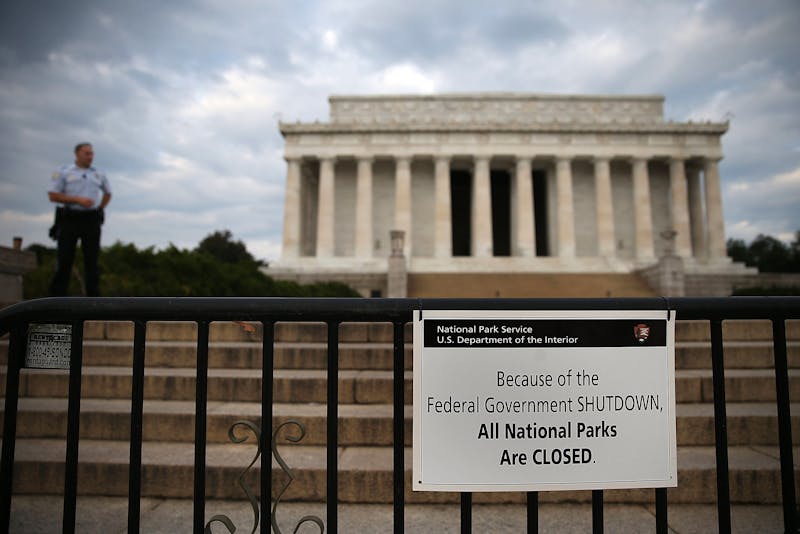During the 21-day government shutdown of 1995-1996, an enormous blizzard left up to three feet of snow in Virginia’s Shenandoah National Park—and no one was there to shovel the parking lots. But that was the least of Bill Wade’s problems. The park’s superintendent at the time, Wade knew that several campers had entered the Shenandoah backcountry before the shutdown. “They were caught back there, and we couldn’t get to them because we had limited staff,” he recalled. “Fortunately we didn’t have any injuries or fatalities, but it could have been a real situation.”
It would have been far worse if visitors had been allowed into Shenandoah during the shutdown, Wade said. The snowstorm hit several days after the shutdown, meaning only a few campers who had entered beforehand were still remaining in the park. If the park had remained open, how many more campers would have been stuck in the snow? Would the limited staff have been able to ensure everyone’s safety?
That’s just one reason Wade is worried about the next potential government shutdown, which will begin at midnight on Friday if the Senate doesn’t pass a bill funding the federal government. (The House passed a bill on Thursday night that would fund the government for nearly a month, but Senate Democrats want concessions not included in that bill.) National parks and monuments usually close during a shutdown, which creates a public relations nightmare for Congress. Vacations are ruined, and businesses suffer.
To avoid that outcry, Department of Interior Secretary Ryan Zinke is reportedly drafting a plan to make sure the parks and monuments remain open if there’s a shutdown. People would still be able to birdwatch in the Everglades and hike in Death Valley—both of which are in peak season—but there wouldn’t be any non-essential National Park Service staff available to help them. That means no educational guides, no maintenance workers, and no park rangers aside from law enforcement. Campground sites, full-service bathrooms, and visitors centers would be closed.
The Washington Post reported that, as of Thursday, there was “wide confusion across the park system” about how this would actually work. “We don’t have a plan yet,” Death Valley National Park spokesperson Abby Wines said. “We just got a memo about this yesterday. Today’s the first day we’re seriously thinking about this.” Experts also told the Post that keeping parks open without non-essential staff would “pose serious risks to tourists as well as to the parks themselves. Park staff provides safety guidance to visitors, including which trails are safe and what sort of equipment is needed to traverse them.”
Wade, who spent more than 30 years at the Park Service and is a founder of the Coalition to Protect America’s National Parks, agreed. “The capacity for rescue if a visitor gets into an accident is going to be limited,” he said. “There might be some EMTs and law enforcement around, but if there’s a problem that needs more people, those people aren’t going to be available.”

Protecting visitors from danger is one worry, but so is protecting the parks from the visitors. “The biggest question in my mind is protection of resources,” Wade said. National parks are protected for a reason, the larger ones often containing sensitive ecosystems, endangered species, coveted petrified wood, and artifacts. Poachers and vandals may see an opportunity in the lack of trail guides and other staffers who monitor the parks. “Archeological resources become more vulnerable for looting, the risk of illegal hunting increases,” Wade said.
And then there’s the issue of bathrooms, which reportedly would close due to a lack of maintenance workers. One current National Park Service employee—a veteran ranger who asked not to be named for fear of retaliation—told me this was legitimately his biggest concern, especially if the shutdown lasts as long as previous ones (the 2013 shutdown lasted 17 days). “That’s the number one thing they teach you in ranger school: You don’t want parks open without bathrooms open,” he said. Large parks, like Death Valley, get about 3,000 visitors a day on average. What happens if there aren’t any bathrooms? “Imagine how much exposed feces there might be,” he said.
The veteran ranger said his co-workers would share his concerns. “These people dedicate their lives to managing and protecting these places, and [Trump’s] saying just open it to the public because they have a right to it—but at the same time, we’re also not allowing you to protect it today,” he said. “Something seems wrong about that to me.” Wade agreed. “The purpose for park staff is to provide visitor services and protect resources,” he said. “I think they would be bothered by their inability to do what they believe they should be doing.”
Zinke’s proposal to keep parks open during a shutdown isn’t motivated by a desire to protect people or parkland. John Czwartacki, a spokesman for the White House budget office, told the Post that the idea was to “ensure that Democrats and other administration critics would not use shuttered parks as political ammunition against Republicans if the government shuts down.” But Democrats have plenty of ammunition whether or not the parks close. The only question is whether it’s a figurative or literal shitstorm.
